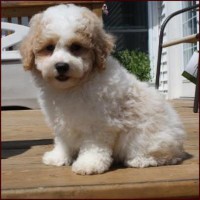Appearance of the Daisy Dog
|
| The Daisy Dog has an attractive appearance that belies a sturdy frame and lively disposition. They are small to medium-sized, with a well-proportioned build. The broad, wide head has ears that can fold back or stand semi-erect. The tail is often long and pointed, although it can be downy on some. The almost almond-shaped eyes are its most attractive feature, appearing to glow, giving it a lively expression. Short, strong legs supported by small, rounded feet can make him surprisingly quick. The nose is black with a short muzzle. The coat is often downy, dense and silky, making this an attractive breed. |
Temperament of the Daisy Dog
|
| The Daisy Dog is a loving, intelligent dog that makes an ideal companion or family dog. They are talented, alert and intelligent. Often small in stature, they surprise owners with just how robust these little dogs can be. They have a gentle disposition and adore children, adults and other pets. The Daisy Dog loves to be part of your life, travels well and loves to curl up on your lap for your attention. They are highly trainable, agile and ready to please. The Daisy Dog likes to be the center of attention and doesn't like to be left alone for long periods at a time. True companions, they consider themselves part of the family and as such want to be included in all family activities. These dogs are as adorable as their name, and just want to be with you. |
Needs and activities of the Daisy Dog
|
| The Daisy Dog is small but still needs daily exercise to keep his energy levels in check. Boredom can produce destructive behavior, so take him out to socialize with other people and dogs at the dog park, or go for a walk around the neighborhood. He'll love toys to play with and will appreciate training that keeps his mind stimulated. The Daisy Dog is intelligent and very easy to train, eager to please and will love all the attention he gets. Avoid harsh methods, as he can be a sensitive dog and will not respond well to them. Family games will be gladly accepted, and they are very affectionate with children and other pets. They especially love cuddles and attention. |
Maintenance of the Daisy Dog
|
| The Daisy Dog is blessed with a low to non-excretion rate and is hypoallergenic. This is a relief for families or allergy sufferers. They are low-maintenance, requiring only regular brushing, perhaps twice a week. A bath is only necessary if it gets a little dirty. Be sure to use a dog shampoo that's gentle on his skin. His ears can be prone to infection, so it's good practice to check for signs of infection or debris build-up and gently wipe them once a week. Grooming time can be rounded off with nail clippers if necessary and a good toothbrush to keep his breath fresh. |










 English (United Kingdom)
English (United Kingdom)